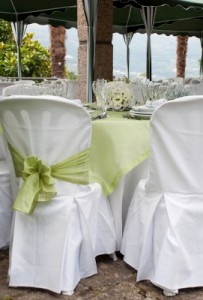 Take a deep breath. A wedding table plan takes some patience and time. It’s like a puzzle — you have X number of tables and X number of guests have to fit at those tables, and you want to seat guests together in a certain way that a) makes them happy and b) makes you happy. The thing is, you might not be able to make EVERYONE happy, so go into it knowing that. Do the best that you can do and try not to overthink it. I happened to shed a few tears planning my seating chart. I think it was because it was the last piece during a long wedding-planning process and I was just ready to go have some fun at that point and not make any more decisions. I laugh at myself thinking back on it, but totally understand why you would feel stressed about your wedding table plan. Here’s some sage advice, which will hopefully help you get through it …
Take a deep breath. A wedding table plan takes some patience and time. It’s like a puzzle — you have X number of tables and X number of guests have to fit at those tables, and you want to seat guests together in a certain way that a) makes them happy and b) makes you happy. The thing is, you might not be able to make EVERYONE happy, so go into it knowing that. Do the best that you can do and try not to overthink it. I happened to shed a few tears planning my seating chart. I think it was because it was the last piece during a long wedding-planning process and I was just ready to go have some fun at that point and not make any more decisions. I laugh at myself thinking back on it, but totally understand why you would feel stressed about your wedding table plan. Here’s some sage advice, which will hopefully help you get through it …
Put the bride and groom first.
Where do you want to sit? Your choices include sitting at your own table, just you and groomy, overlooking the wedding reception or right smack in the middle of it. You can also choose to sit at a table with all of your family and/or your wedding party. You don’t even have to sit with your family — it’s up to you! You could instead sit at the head or middle of a long table with your friends and bridal party. Once you know where you two want to be, the rest will fall into place.
Seating logistics
You can fit eight people comfortably at a 60-inch round table (a popular wedding table size). Ten feels crowded and six feels a bit empty. If you choose a rectangular table, they are typically 6 feet long. You can seat six or eight people at one of these, depending on if you put a chair at either end or not.
Mapping it out
Sites like Wedding Wire have software programs that can help you with your wedding table plan, but I like a good old-fashioned Excel grid, especially if you are working with rectangular or square tables. Color the fields that represent each seat of your table and add the names. Technology a little too technical for you? You can always do it the hard-copy way with pieces of paper representing each table and sticky notes (tip: you can use Post-It® notes or even return address labels) representing each person.

Mix and match your groups
Instead of grouping all of your family together, then his family, then your single friends, then your college friends, etc., consider mixing it up. Sure, it might make the most sense to pair family with family, however, try to blend your groups so that they have the opportunity to meet some cool new people. And don’t just stick all your singles at one lonesome table — they’d like to mingle with your coupled-up friends, too. It’s a nice idea to put a couple or few singles with a couple or few couples, if possible. Where it is perfectly acceptable to put like with like is where the kids are concerned. No one — I repeat, no one — wants to sit next to a child at your wedding. Place the kiddos under 12 at their own tables and arrange for babysitters/nannies to take care of them during the reception.
Don’t overthink it
In the end, your guests are thrilled to be at your wedding, celebrating you! Hopefully, if they don’t love their seat, they will get over it quickly since it’s only for a limited period of time anyway. Just remember, all seating will be forgotten once they hit the dance floor.
What kind of seating did you choose for your wedding tables? Is there anything you would have changed?
Let us know in the comments below, or connect with us on Facebook, Twitter or Google+. Looking for some additional Wedding PINspiration? Check out our Wedding Boards on Pinterest!

Great post! I always wonder what to do with the officiant.
Rachel – Great question! I started thinking about that myself as well and came across this post from The Knot: http://wedding.theknot.com/wedding-planning/wedding-reception-planning/qa/where-to-seat-officiant.aspx?MsdVisit=1